Managing Quality: A Case Study of the TUI Group's Challenges
VerifiedAdded on 2023/01/12
|7
|1343
|96
Case Study
AI Summary
This case study analyzes the quality issues faced by the TUI Group, a multinational travel and tourism company. It begins with an introduction to TUI, its industry position, and the identified quality issues, particularly concerning customer service dissatisfaction in 2019. The report utilizes the Gap Model of Service Quality to pinpoint gaps between customer expectations and actual service delivery, focusing on poor grievance handling and responsiveness. It then assesses TUI's resources, competencies, and capabilities, highlighting the need for improved customer service to gain a competitive edge. The financial performance is reviewed, showing that despite high revenues, net profits declined, indicating increased operational costs. The study recommends that TUI Group adopts total quality management principles, specifically the PDCA Cycle, to improve customer satisfaction and service quality. The report provides a framework for planning, testing, evaluating, and implementing solutions to enhance customer service and overall business performance.
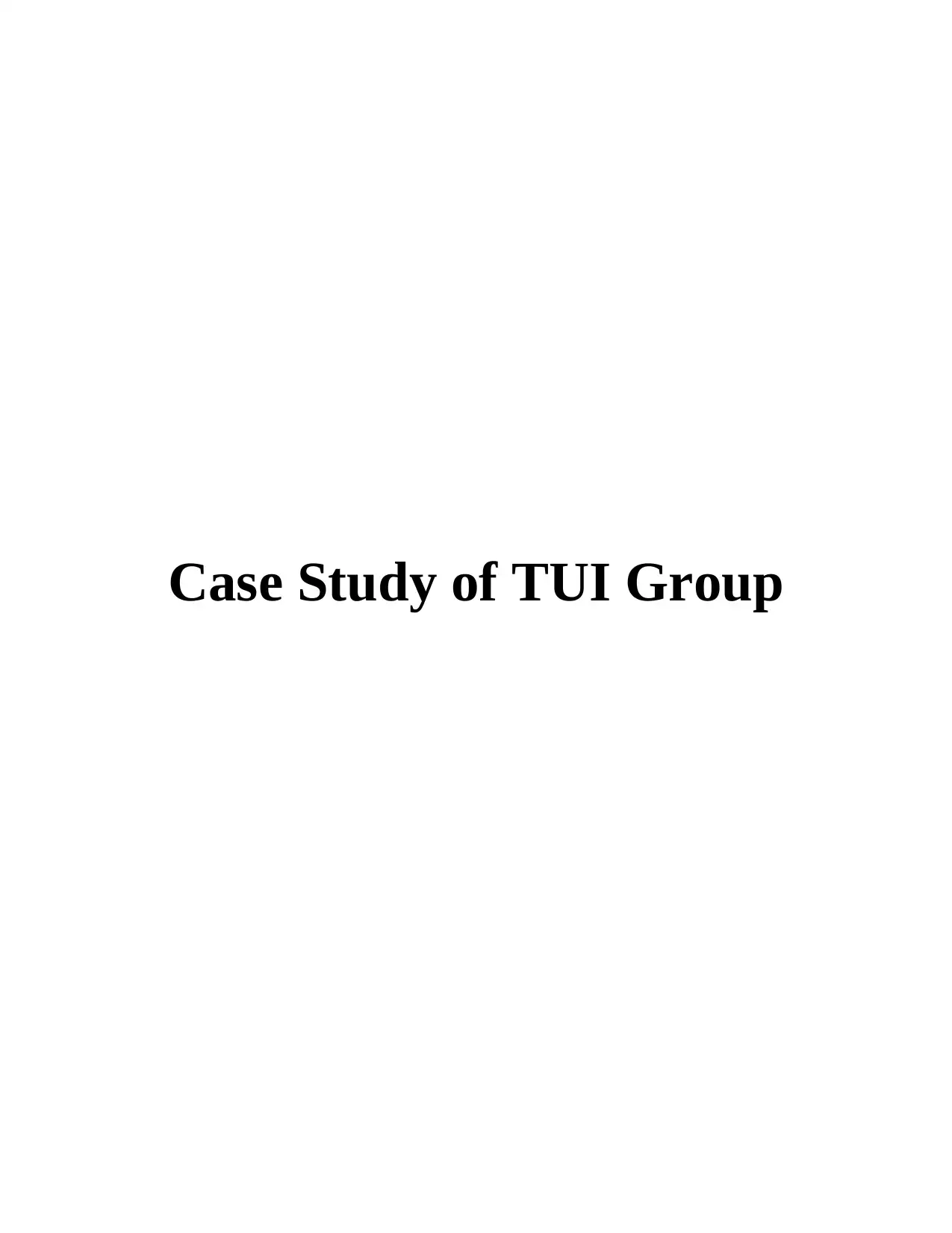
Case Study of TUI Group
Paraphrase This Document
Need a fresh take? Get an instant paraphrase of this document with our AI Paraphraser
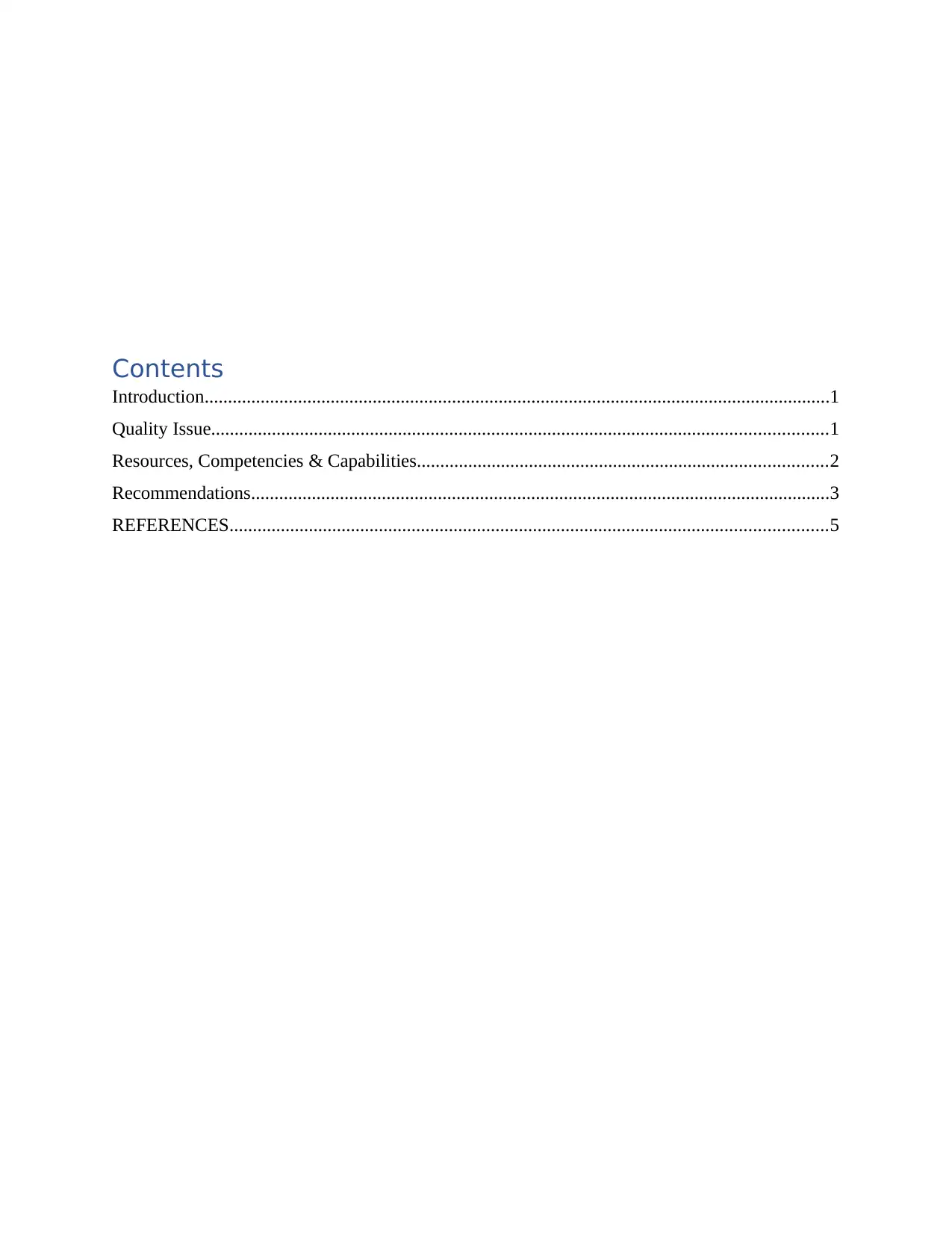
Contents
Introduction......................................................................................................................................1
Quality Issue....................................................................................................................................1
Resources, Competencies & Capabilities........................................................................................2
Recommendations............................................................................................................................3
REFERENCES................................................................................................................................5
Introduction......................................................................................................................................1
Quality Issue....................................................................................................................................1
Resources, Competencies & Capabilities........................................................................................2
Recommendations............................................................................................................................3
REFERENCES................................................................................................................................5
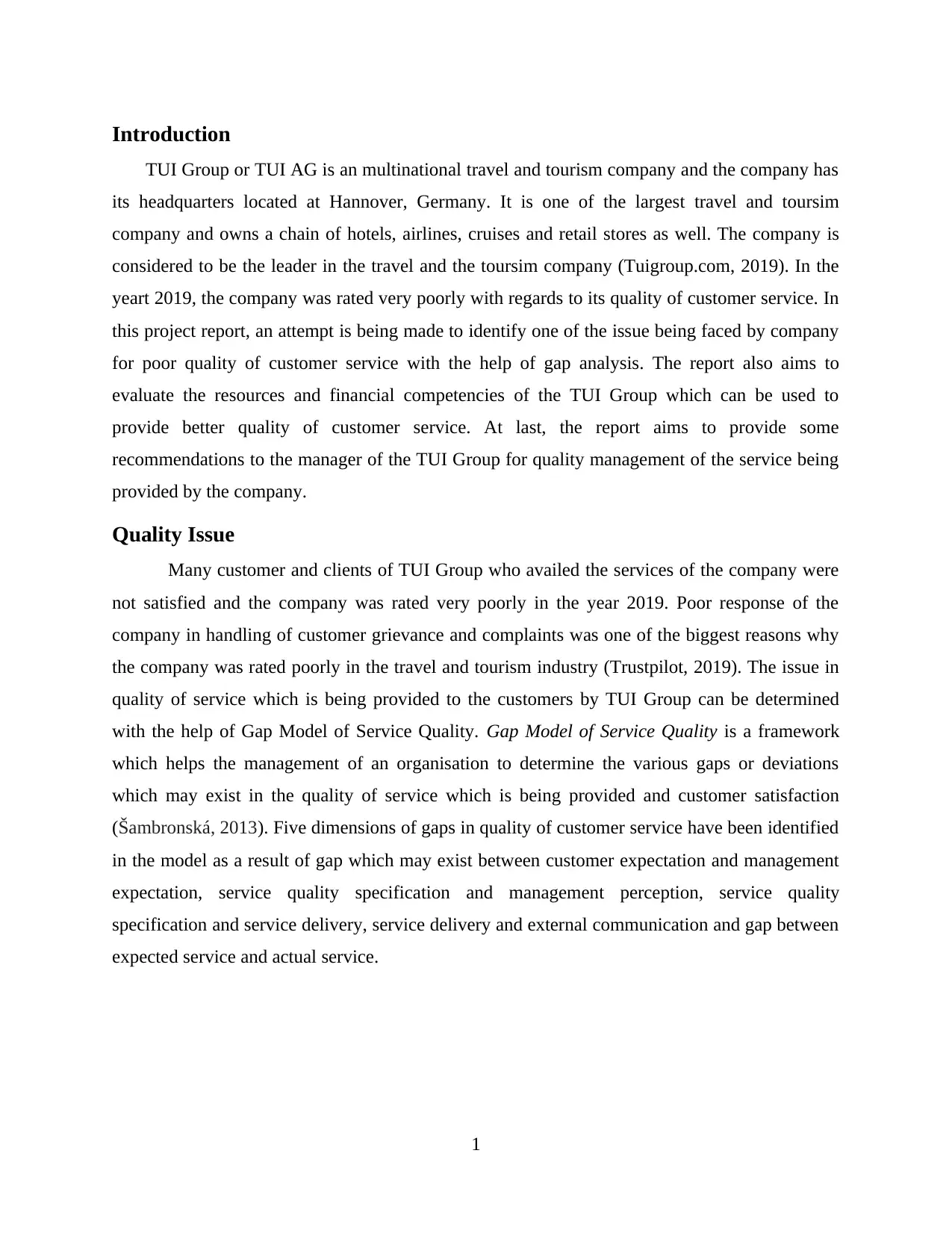
Introduction
TUI Group or TUI AG is an multinational travel and tourism company and the company has
its headquarters located at Hannover, Germany. It is one of the largest travel and toursim
company and owns a chain of hotels, airlines, cruises and retail stores as well. The company is
considered to be the leader in the travel and the toursim company (Tuigroup.com, 2019). In the
yeart 2019, the company was rated very poorly with regards to its quality of customer service. In
this project report, an attempt is being made to identify one of the issue being faced by company
for poor quality of customer service with the help of gap analysis. The report also aims to
evaluate the resources and financial competencies of the TUI Group which can be used to
provide better quality of customer service. At last, the report aims to provide some
recommendations to the manager of the TUI Group for quality management of the service being
provided by the company.
Quality Issue
Many customer and clients of TUI Group who availed the services of the company were
not satisfied and the company was rated very poorly in the year 2019. Poor response of the
company in handling of customer grievance and complaints was one of the biggest reasons why
the company was rated poorly in the travel and tourism industry (Trustpilot, 2019). The issue in
quality of service which is being provided to the customers by TUI Group can be determined
with the help of Gap Model of Service Quality. Gap Model of Service Quality is a framework
which helps the management of an organisation to determine the various gaps or deviations
which may exist in the quality of service which is being provided and customer satisfaction
(Šambronská, 2013). Five dimensions of gaps in quality of customer service have been identified
in the model as a result of gap which may exist between customer expectation and management
expectation, service quality specification and management perception, service quality
specification and service delivery, service delivery and external communication and gap between
expected service and actual service.
1
TUI Group or TUI AG is an multinational travel and tourism company and the company has
its headquarters located at Hannover, Germany. It is one of the largest travel and toursim
company and owns a chain of hotels, airlines, cruises and retail stores as well. The company is
considered to be the leader in the travel and the toursim company (Tuigroup.com, 2019). In the
yeart 2019, the company was rated very poorly with regards to its quality of customer service. In
this project report, an attempt is being made to identify one of the issue being faced by company
for poor quality of customer service with the help of gap analysis. The report also aims to
evaluate the resources and financial competencies of the TUI Group which can be used to
provide better quality of customer service. At last, the report aims to provide some
recommendations to the manager of the TUI Group for quality management of the service being
provided by the company.
Quality Issue
Many customer and clients of TUI Group who availed the services of the company were
not satisfied and the company was rated very poorly in the year 2019. Poor response of the
company in handling of customer grievance and complaints was one of the biggest reasons why
the company was rated poorly in the travel and tourism industry (Trustpilot, 2019). The issue in
quality of service which is being provided to the customers by TUI Group can be determined
with the help of Gap Model of Service Quality. Gap Model of Service Quality is a framework
which helps the management of an organisation to determine the various gaps or deviations
which may exist in the quality of service which is being provided and customer satisfaction
(Šambronská, 2013). Five dimensions of gaps in quality of customer service have been identified
in the model as a result of gap which may exist between customer expectation and management
expectation, service quality specification and management perception, service quality
specification and service delivery, service delivery and external communication and gap between
expected service and actual service.
1
⊘ This is a preview!⊘
Do you want full access?
Subscribe today to unlock all pages.

Trusted by 1+ million students worldwide
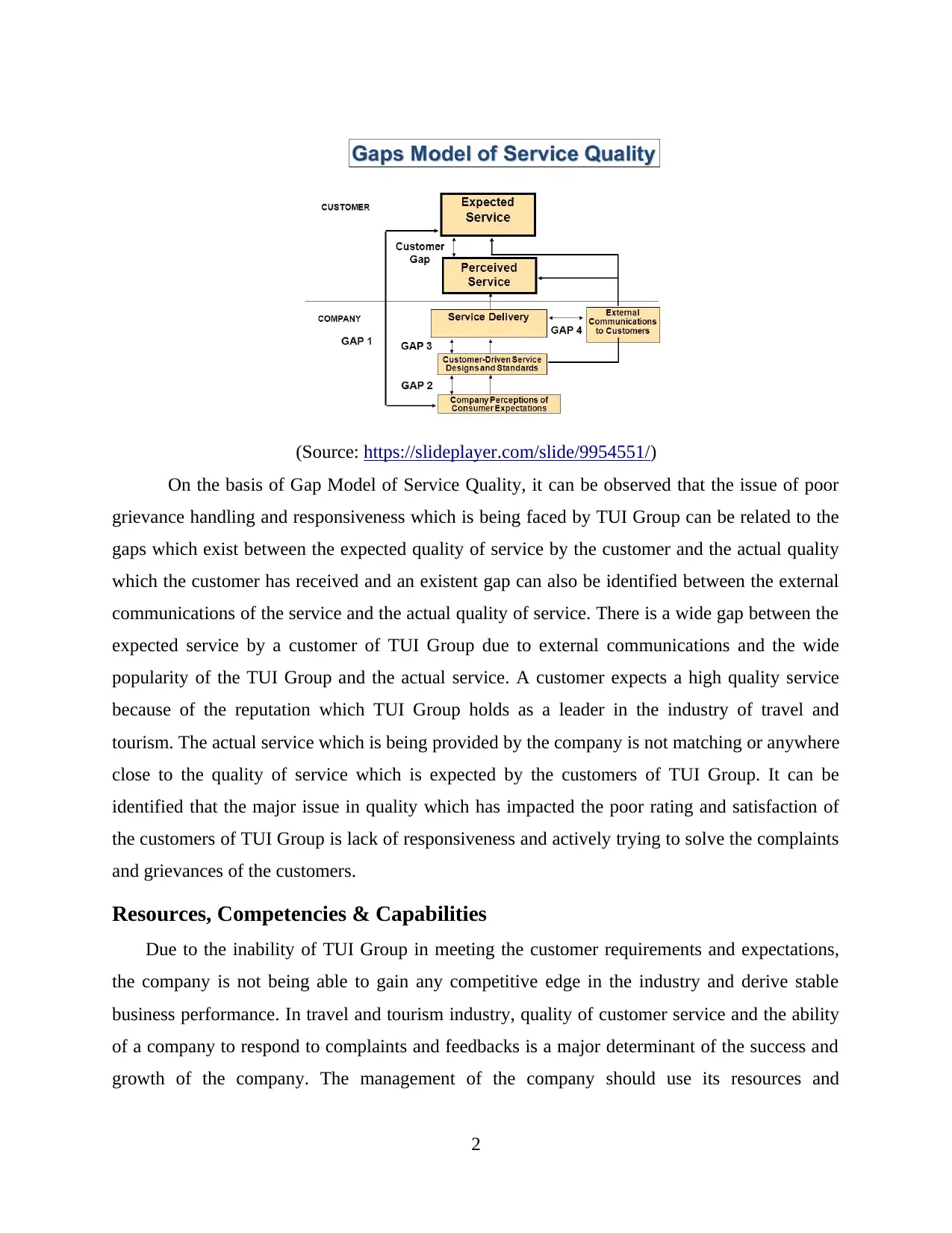
(Source: https://slideplayer.com/slide/9954551/)
On the basis of Gap Model of Service Quality, it can be observed that the issue of poor
grievance handling and responsiveness which is being faced by TUI Group can be related to the
gaps which exist between the expected quality of service by the customer and the actual quality
which the customer has received and an existent gap can also be identified between the external
communications of the service and the actual quality of service. There is a wide gap between the
expected service by a customer of TUI Group due to external communications and the wide
popularity of the TUI Group and the actual service. A customer expects a high quality service
because of the reputation which TUI Group holds as a leader in the industry of travel and
tourism. The actual service which is being provided by the company is not matching or anywhere
close to the quality of service which is expected by the customers of TUI Group. It can be
identified that the major issue in quality which has impacted the poor rating and satisfaction of
the customers of TUI Group is lack of responsiveness and actively trying to solve the complaints
and grievances of the customers.
Resources, Competencies & Capabilities
Due to the inability of TUI Group in meeting the customer requirements and expectations,
the company is not being able to gain any competitive edge in the industry and derive stable
business performance. In travel and tourism industry, quality of customer service and the ability
of a company to respond to complaints and feedbacks is a major determinant of the success and
growth of the company. The management of the company should use its resources and
2
On the basis of Gap Model of Service Quality, it can be observed that the issue of poor
grievance handling and responsiveness which is being faced by TUI Group can be related to the
gaps which exist between the expected quality of service by the customer and the actual quality
which the customer has received and an existent gap can also be identified between the external
communications of the service and the actual quality of service. There is a wide gap between the
expected service by a customer of TUI Group due to external communications and the wide
popularity of the TUI Group and the actual service. A customer expects a high quality service
because of the reputation which TUI Group holds as a leader in the industry of travel and
tourism. The actual service which is being provided by the company is not matching or anywhere
close to the quality of service which is expected by the customers of TUI Group. It can be
identified that the major issue in quality which has impacted the poor rating and satisfaction of
the customers of TUI Group is lack of responsiveness and actively trying to solve the complaints
and grievances of the customers.
Resources, Competencies & Capabilities
Due to the inability of TUI Group in meeting the customer requirements and expectations,
the company is not being able to gain any competitive edge in the industry and derive stable
business performance. In travel and tourism industry, quality of customer service and the ability
of a company to respond to complaints and feedbacks is a major determinant of the success and
growth of the company. The management of the company should use its resources and
2
Paraphrase This Document
Need a fresh take? Get an instant paraphrase of this document with our AI Paraphraser
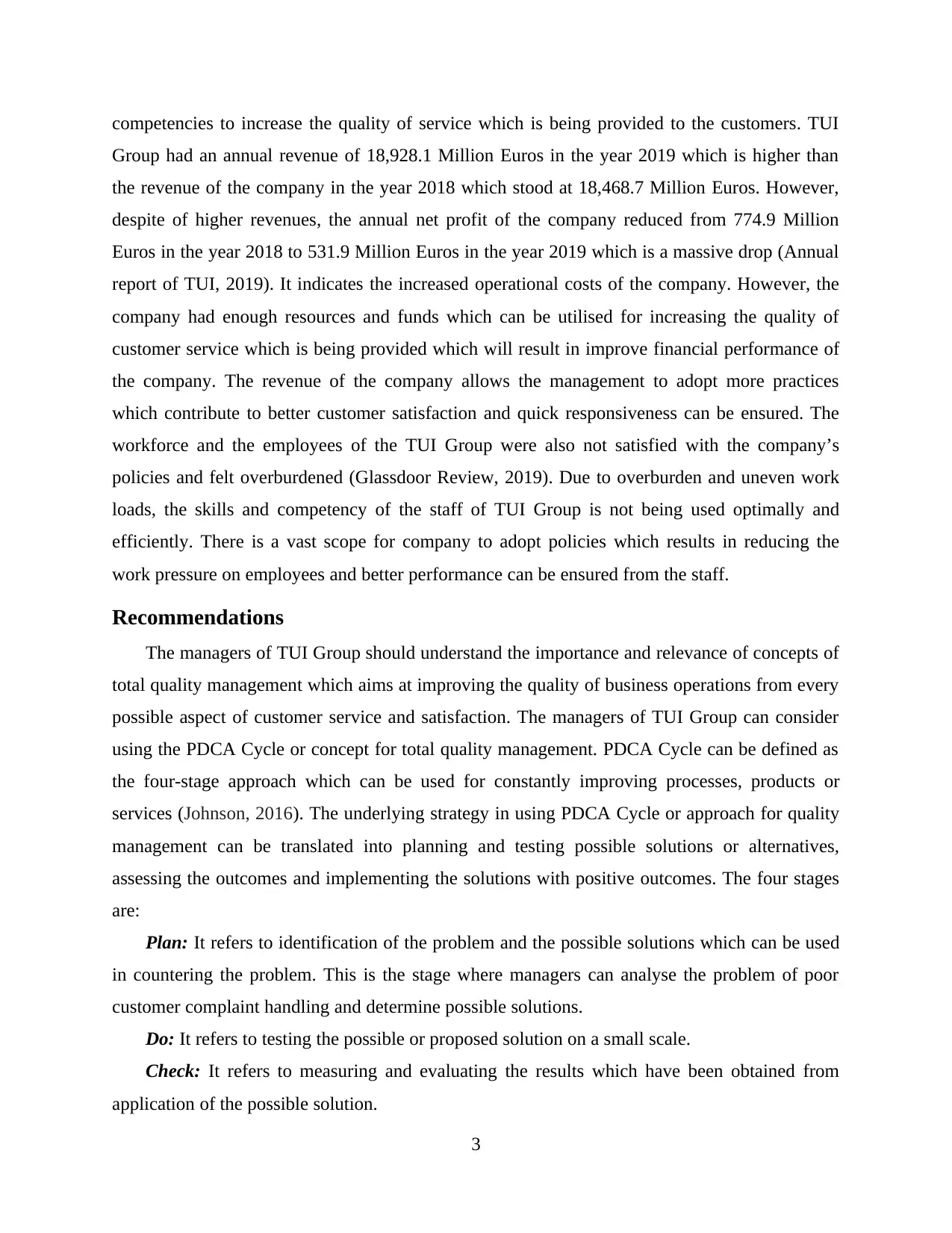
competencies to increase the quality of service which is being provided to the customers. TUI
Group had an annual revenue of 18,928.1 Million Euros in the year 2019 which is higher than
the revenue of the company in the year 2018 which stood at 18,468.7 Million Euros. However,
despite of higher revenues, the annual net profit of the company reduced from 774.9 Million
Euros in the year 2018 to 531.9 Million Euros in the year 2019 which is a massive drop (Annual
report of TUI, 2019). It indicates the increased operational costs of the company. However, the
company had enough resources and funds which can be utilised for increasing the quality of
customer service which is being provided which will result in improve financial performance of
the company. The revenue of the company allows the management to adopt more practices
which contribute to better customer satisfaction and quick responsiveness can be ensured. The
workforce and the employees of the TUI Group were also not satisfied with the company’s
policies and felt overburdened (Glassdoor Review, 2019). Due to overburden and uneven work
loads, the skills and competency of the staff of TUI Group is not being used optimally and
efficiently. There is a vast scope for company to adopt policies which results in reducing the
work pressure on employees and better performance can be ensured from the staff.
Recommendations
The managers of TUI Group should understand the importance and relevance of concepts of
total quality management which aims at improving the quality of business operations from every
possible aspect of customer service and satisfaction. The managers of TUI Group can consider
using the PDCA Cycle or concept for total quality management. PDCA Cycle can be defined as
the four-stage approach which can be used for constantly improving processes, products or
services (Johnson, 2016). The underlying strategy in using PDCA Cycle or approach for quality
management can be translated into planning and testing possible solutions or alternatives,
assessing the outcomes and implementing the solutions with positive outcomes. The four stages
are:
Plan: It refers to identification of the problem and the possible solutions which can be used
in countering the problem. This is the stage where managers can analyse the problem of poor
customer complaint handling and determine possible solutions.
Do: It refers to testing the possible or proposed solution on a small scale.
Check: It refers to measuring and evaluating the results which have been obtained from
application of the possible solution.
3
Group had an annual revenue of 18,928.1 Million Euros in the year 2019 which is higher than
the revenue of the company in the year 2018 which stood at 18,468.7 Million Euros. However,
despite of higher revenues, the annual net profit of the company reduced from 774.9 Million
Euros in the year 2018 to 531.9 Million Euros in the year 2019 which is a massive drop (Annual
report of TUI, 2019). It indicates the increased operational costs of the company. However, the
company had enough resources and funds which can be utilised for increasing the quality of
customer service which is being provided which will result in improve financial performance of
the company. The revenue of the company allows the management to adopt more practices
which contribute to better customer satisfaction and quick responsiveness can be ensured. The
workforce and the employees of the TUI Group were also not satisfied with the company’s
policies and felt overburdened (Glassdoor Review, 2019). Due to overburden and uneven work
loads, the skills and competency of the staff of TUI Group is not being used optimally and
efficiently. There is a vast scope for company to adopt policies which results in reducing the
work pressure on employees and better performance can be ensured from the staff.
Recommendations
The managers of TUI Group should understand the importance and relevance of concepts of
total quality management which aims at improving the quality of business operations from every
possible aspect of customer service and satisfaction. The managers of TUI Group can consider
using the PDCA Cycle or concept for total quality management. PDCA Cycle can be defined as
the four-stage approach which can be used for constantly improving processes, products or
services (Johnson, 2016). The underlying strategy in using PDCA Cycle or approach for quality
management can be translated into planning and testing possible solutions or alternatives,
assessing the outcomes and implementing the solutions with positive outcomes. The four stages
are:
Plan: It refers to identification of the problem and the possible solutions which can be used
in countering the problem. This is the stage where managers can analyse the problem of poor
customer complaint handling and determine possible solutions.
Do: It refers to testing the possible or proposed solution on a small scale.
Check: It refers to measuring and evaluating the results which have been obtained from
application of the possible solution.
3
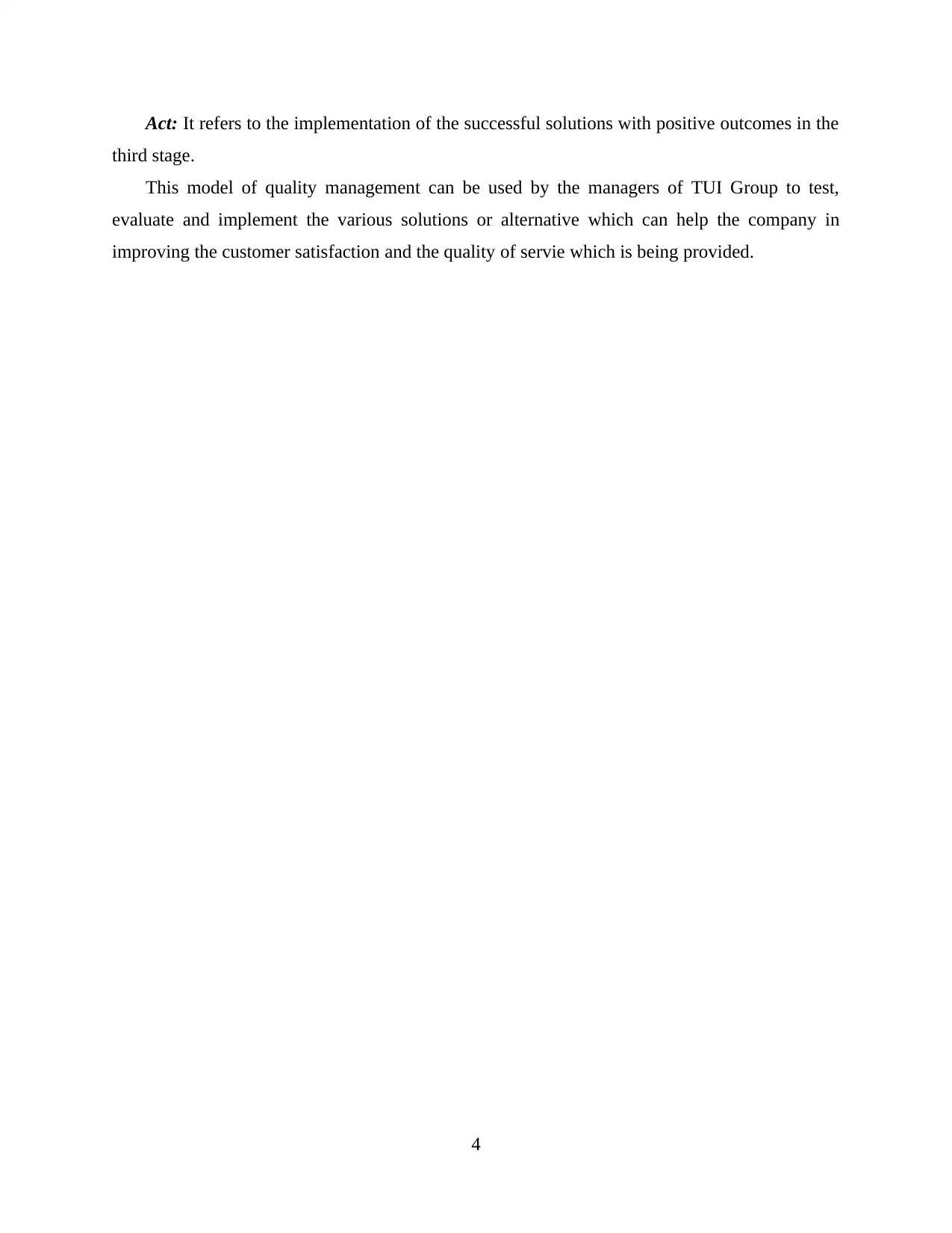
Act: It refers to the implementation of the successful solutions with positive outcomes in the
third stage.
This model of quality management can be used by the managers of TUI Group to test,
evaluate and implement the various solutions or alternative which can help the company in
improving the customer satisfaction and the quality of servie which is being provided.
4
third stage.
This model of quality management can be used by the managers of TUI Group to test,
evaluate and implement the various solutions or alternative which can help the company in
improving the customer satisfaction and the quality of servie which is being provided.
4
⊘ This is a preview!⊘
Do you want full access?
Subscribe today to unlock all pages.

Trusted by 1+ million students worldwide
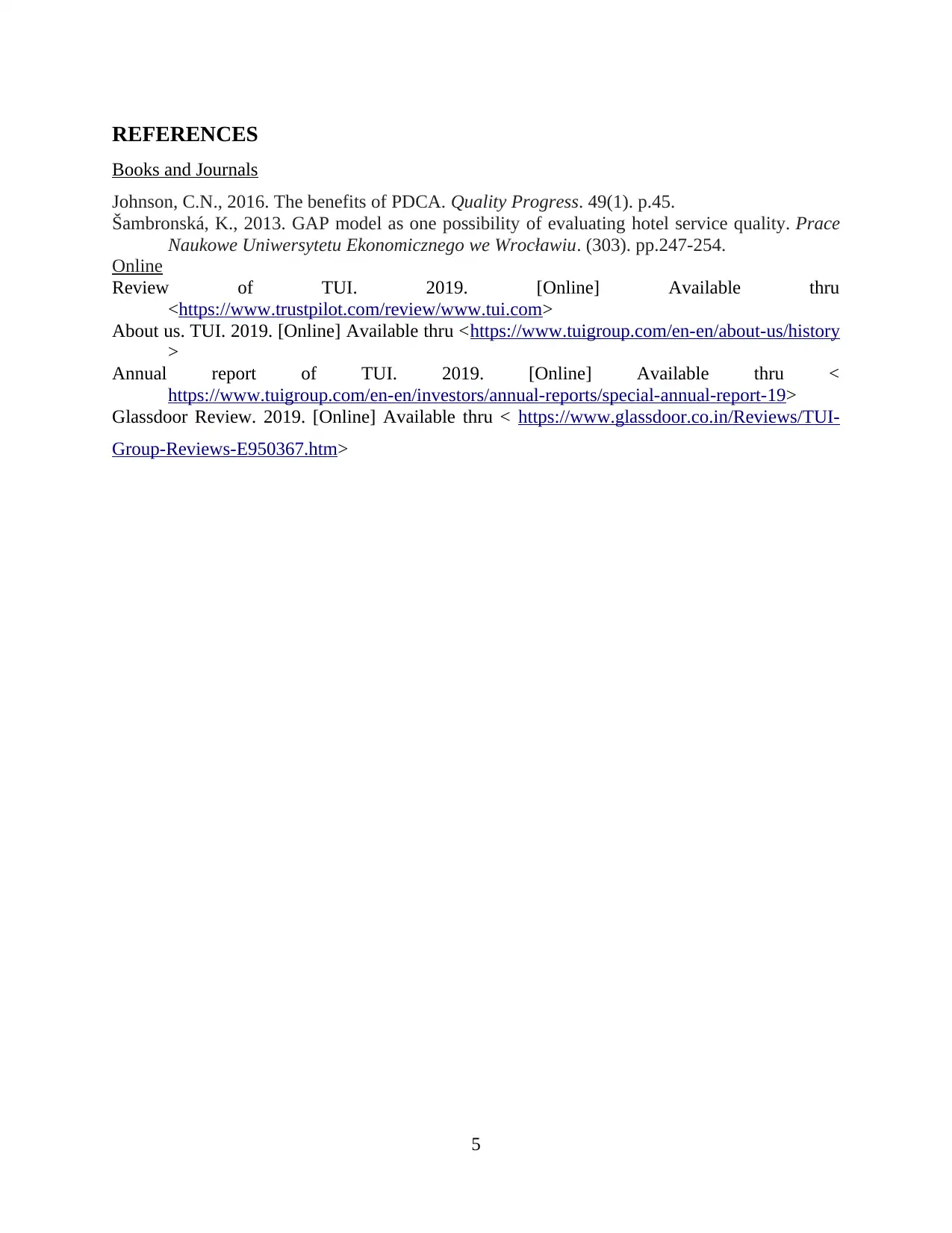
REFERENCES
Books and Journals
Johnson, C.N., 2016. The benefits of PDCA. Quality Progress. 49(1). p.45.
Šambronská, K., 2013. GAP model as one possibility of evaluating hotel service quality. Prace
Naukowe Uniwersytetu Ekonomicznego we Wrocławiu. (303). pp.247-254.
Online
Review of TUI. 2019. [Online] Available thru
<https://www.trustpilot.com/review/www.tui.com>
About us. TUI. 2019. [Online] Available thru <https://www.tuigroup.com/en-en/about-us/history
>
Annual report of TUI. 2019. [Online] Available thru <
https://www.tuigroup.com/en-en/investors/annual-reports/special-annual-report-19>
Glassdoor Review. 2019. [Online] Available thru < https://www.glassdoor.co.in/Reviews/TUI-
Group-Reviews-E950367.htm>
5
Books and Journals
Johnson, C.N., 2016. The benefits of PDCA. Quality Progress. 49(1). p.45.
Šambronská, K., 2013. GAP model as one possibility of evaluating hotel service quality. Prace
Naukowe Uniwersytetu Ekonomicznego we Wrocławiu. (303). pp.247-254.
Online
Review of TUI. 2019. [Online] Available thru
<https://www.trustpilot.com/review/www.tui.com>
About us. TUI. 2019. [Online] Available thru <https://www.tuigroup.com/en-en/about-us/history
>
Annual report of TUI. 2019. [Online] Available thru <
https://www.tuigroup.com/en-en/investors/annual-reports/special-annual-report-19>
Glassdoor Review. 2019. [Online] Available thru < https://www.glassdoor.co.in/Reviews/TUI-
Group-Reviews-E950367.htm>
5
1 out of 7
Related Documents
Your All-in-One AI-Powered Toolkit for Academic Success.
+13062052269
info@desklib.com
Available 24*7 on WhatsApp / Email
![[object Object]](/_next/static/media/star-bottom.7253800d.svg)
Unlock your academic potential
Copyright © 2020–2025 A2Z Services. All Rights Reserved. Developed and managed by ZUCOL.



